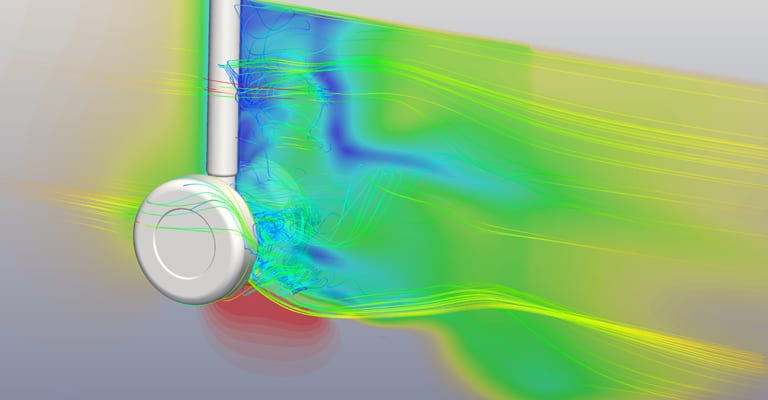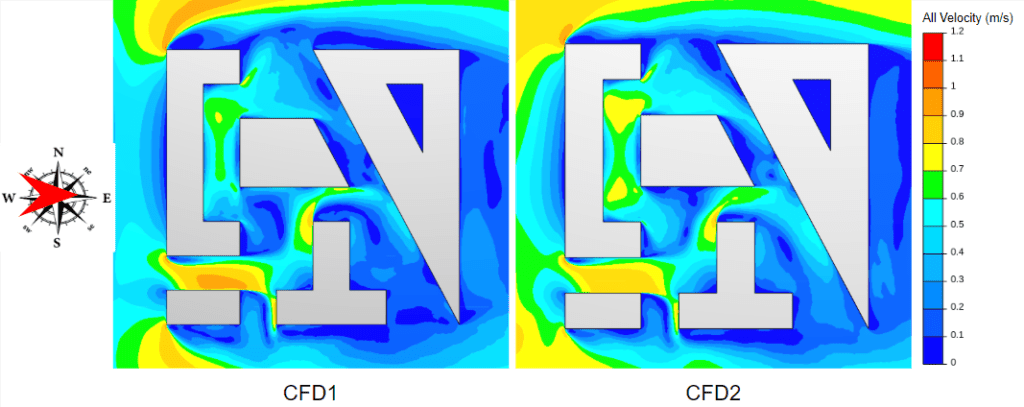Documentation
Turbulent flow often requires substantial computational power to simulate accurately. CFD simulations simplify the problem to reduce computing time while maintaining or improving accuracy. Large Eddy Simulation (LES) is one of those CFD techniques that balances detailed simulations with manageable computing demands.
In this article, we’ll explore LES in detail – what it is, how it differs from other CFD models, and why it’s often the best choice for certain simulation needs. We’ll also discuss its practical applications and how it is implemented in SimScale.
Large Eddy Simulation (LES) is a mathematical model for simulating turbulent flow in computational fluid dynamics. It’s particularly valuable in sectors like aerospace and automotive, where understanding how fluids interact with various structures is critical. The roots of LES trace back to 1963, when Joseph Smagorinsky proposed it to simulate atmospheric air currents. Its first significant exploration was by Deardorff in 1970.
LES focuses on larger eddies (whirls of fluid) in a flow, influenced by the geometry of the flow, while the smaller, more universal scales are modeled using a subgrid-scale (SGS) model. This methodology stems from Kolmogorov’s 1941 theory of self-similarity, which suggests that larger eddies are shaped by flow geometry, whereas smaller scales are more universal.
At its core, LES deals with fluid behavior using the Navier-Stokes equations, which are fundamental in fluid dynamics. These equations cover three main areas:
Now, let’s talk about the filtering kernel in LES. This filtering process is crucial for LES because it simplifies these complex Navier-Stokes equations.
The kernel works by focusing on the larger eddies in the fluid, which are the main drivers of flow patterns in turbulence, and averages out the effects of the smaller eddies. This is done through a mathematical operation known as convolution, which blends the fluid’s characteristics over a particular scale.
The filtering operation in Large Eddy Simulation (LES) is generally expressed in the following integral form:
$$ \bar{\phi} (x,t) = \int_{-\infty}^{+\infty} \int_{-\infty}^{+\infty} \phi (r,\tau)G(x-r, t-\tau)drd\tau $$
where:
After filtering, the field variable is split into two parts:
Together, the total field variable is described as the sum of both the filtered and subgrid components:
$$ \phi = \bar{\phi} + \phi’ $$
The LES-filtered Navier-Stokes equation for an incompressible fluid flow, which assumes constant density and no divergence, is shown below. In Einstein’s notation, it is:
$$ \frac{\partial \bar{u_i}}{\partial t} + \frac{\partial}{\partial x_j}(\bar{u_i}\bar{u_j}) = -\frac{1}{\rho} \frac{\partial \bar{p}}{\partial x_i} + \nu \left(\frac{\partial^2 \bar{u_i}}{\partial x_j^2} + \frac{\partial^2 \bar{u_j}}{\partial x_i^2}\right) $$
The LES approach for compressible flow involves additional considerations for density changes.
$$ \frac{\partial \bar{\rho}u_i}{\partial t} + \frac{\partial \bar{\rho}u_i u_j}{\partial x_j} + \frac{\partial p}{\partial x_i} – \frac{\partial \bar{\sigma_{ij}}}{\partial x_j} = – \frac{\partial \bar{\rho} \tau_{ij}}{\partial x_j} + \frac{\partial}{\partial x_j}(\bar{\sigma_{ij}} – \bar{\bar{\sigma_{ij}}}) $$
The filtered motion equation for compressible flow within LES accounts for variations in fluid density and includes modifications to the stress terms to reflect the fluid’s response to being compressed. This variant of the motion equation is often referred to as the Favre-averaged Navier-Stokes equation.
Large Eddy Simulation (LES) is your go-to computational fluid dynamics (CFD) model when the flow’s transient and turbulent structures are critical to capture. Unlike steady models, such as the Reynolds-Averaged Navier-Stokes (RANS) turbulence model, which offers time-averaged results, LES can detail the fluctuating components of turbulence that evolve over time.
In many complex flow scenarios, RANS models fall short as they cannot accurately represent the entire flow field, especially when the turbulent fluctuations are not just minor disturbances but significant enough to influence the mean flow.
Here are the key differences between LES, RANS, and DNS mathematical models:
| Feature | DNS | LES | RANS |
|---|---|---|---|
| Applications | Simple flow, low Re number | Simple flow, low Re number | Wide range |
| Computational Power | Very high demand | Less demand than DNS, higher than RANS | Least demand |
| Accuracy | Most accurate | More accurate than RANS, less than DNS | Least accurate |
| Complexity | Can’t handle complex systems due to computational load | Handles more complexity than RANS | Can handle complex systems |
| Turbulence | Resolves all scales of turbulence | Resolves large scales, models small scales | Models all scales of turbulence |
| Suitability | Academic and theoretical studies | Flows with significant large-scale turbulence | Industrial and practical applications where efficiency is key |
| Cost | Prohibitively high for most practical applications | High but more feasible than DNS | Economical and practical |
| Typical Use Case | Fundamental research, low Reynolds number flows | Transitional and complex turbulence not suited for RANS | Flows where turbulence is well-behaved and predictable |
Here are some key areas where LES is making a significant impact:
SimScale takes the complexity out of running Large Eddy Simulations (LES). Here, you can explore the behavior of simple laminar flows and more complex turbulent flows.
With SimScale’s entire cloud-native platform operating directly through your web browser, you’re free from the constraints of computing power, accessibility issues, and the steep costs typically associated with advanced simulations. By relying on cloud computing capabilities, you are able to run as many simulations as you need simultaneously without hardware constraints. You can also access your simulation projects anytime and anywhere by simply tapping into your web browser.
LES is one of many turbulence models that can be simulated in SimScale, such as the K-epsilon, K-omega, and K-omega SST models. By applying LES, the smallest scales of turbulence would be spatially filtered out to be modeled, and the largest, most energy-containing scales would be resolved by the mesh. Such a method allows for relatively coarse mesh resolution (compared to DNS), which makes it more widely applicable to different types of fluid flow problems.
SimScale offers three LES turbulence models, namely:
Consider the challenge of reducing the roar from an aircraft’s landing gear. This is where LES shines. On SimScale, you can map out how air whirls around the wheels and struts, ensuring the safety of the plane and passengers.
Here, the LES Smagorinski model for sub-grid scales was used after a mesh of 1.8 million nodes was applied (using SimScale’s SnappyHexMesh). The free stream flow velocity (Air) is set to be 35 m/s at standard conditions. A ramping of the velocity boundary condition was applied to gradually increase the velocity from a low value to a free-stream value for faster convergence.

Another example explores the accuracy of SimScale’s Lattice Boltzmann Method (LBM) compared to wind tunnel tests conducted by two German institutes. The image below demonstrates this validation case, comparing the LES results from two different wind tunnel tests.
For this project, a turbulence model that combines both LES and RANS was used, called k-Omega SST (or Delayed Detached Eddy Simulation (DDES)). This method enables the simulation to switch between both LES and RANS. Based on this, the findings showed a good agreement between the simulation results and wind tunnel test results. If you are interested in the details of this comparison, read the validation case here.

Ready to see LES in action? Start Simulating on SimScale by clicking the button below and push your designs forward with confidence.
Last updated: December 7th, 2023
We appreciate and value your feedback.
What's Next
What is Valve Flow Coefficient?Sign up for SimScale
and start simulating now